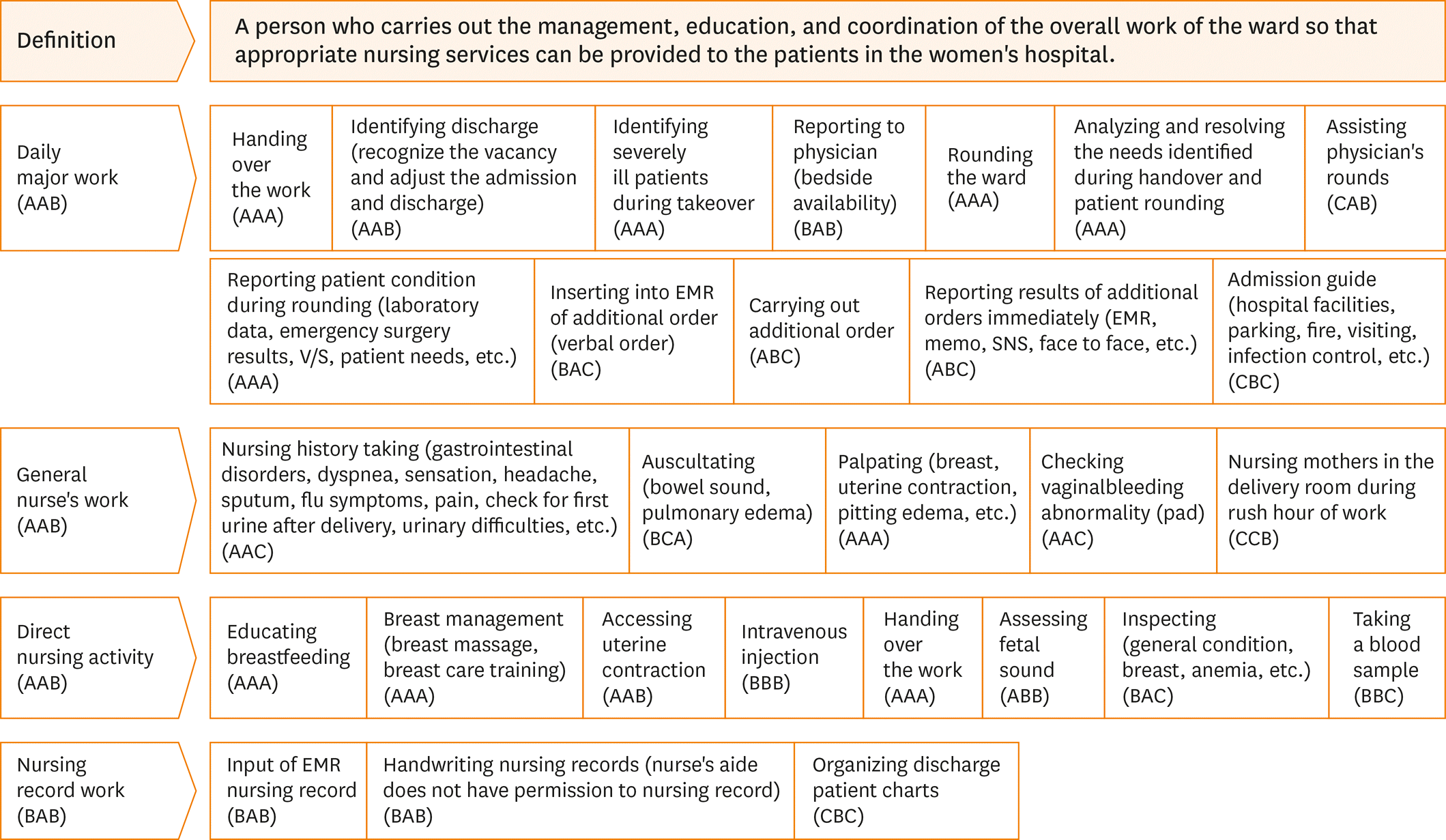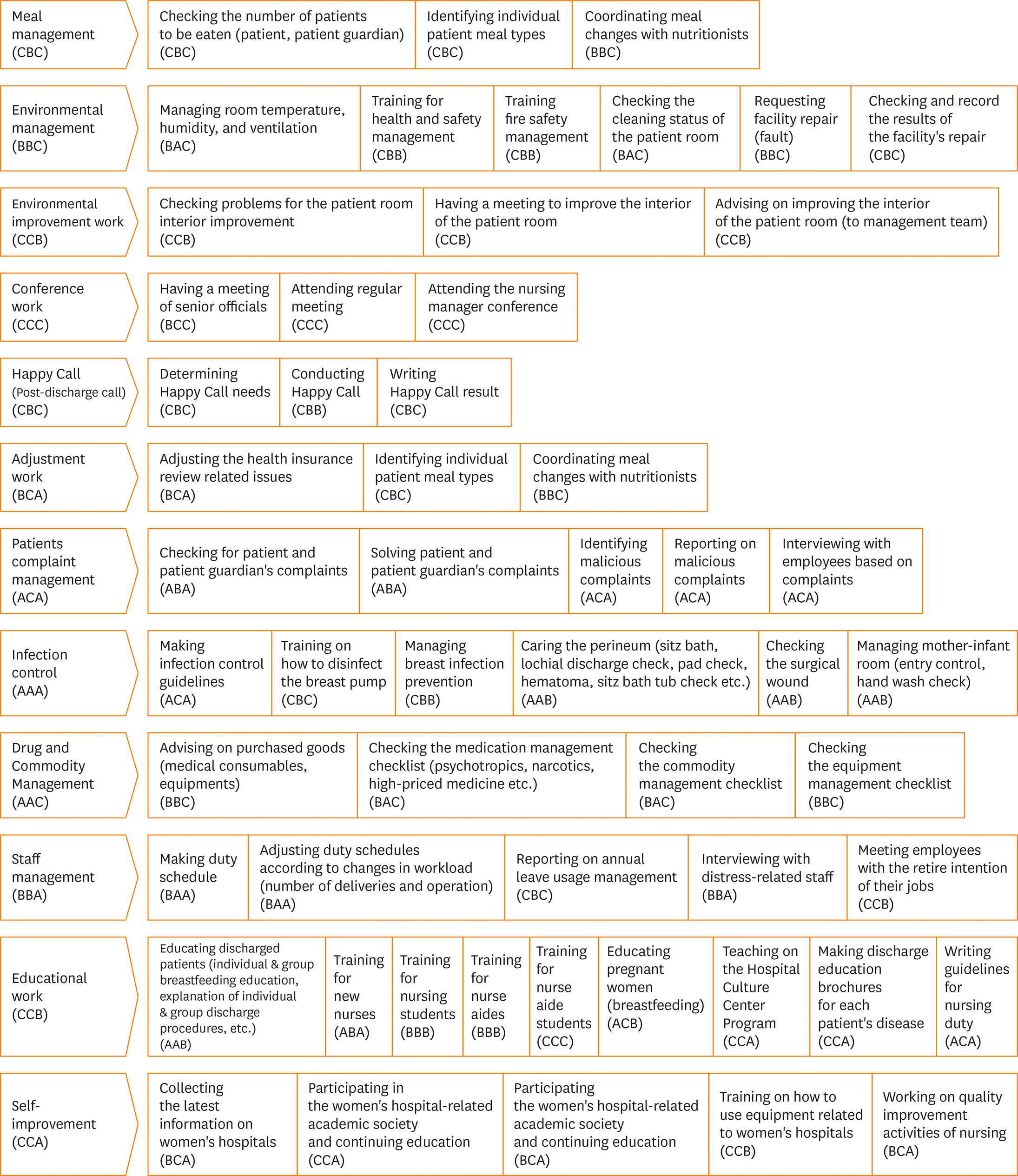Abstract
Purpose
To analyze the job of nursing unit managers working at women’s hospital, using DACUM (developing a curriculum), DACUM is a method for analyzing job-focused competency.
Methods
This study involved a descriptive survey. A DACUM workshop was held to define wom-en’s hospital nursing unit managers’ role and identify their duties and tasks. For the workshop, a committee was formed consisting of 5 women’s hospital nursing unit managers. Finally, after validation, the developed contents were made into a survey asking about nursing unit manager’s duties and tasks.
Results
Sixteen duties and 83 tasks were identified on the DACUM chart. The importance, difficulty, and frequency of the tasks were ranked in terms of A, B, and C, with A being the highest degree. Eight tasks received A’s all in importance, difficulty, and frequency of performance. The 8 tasks were: ‘taking over’, ‘taking care of seriously ill patients on handover’, ‘ward rounding’, ‘analyzing and resolving demands identified during handover and patient tour’, ‘reporting patient status during rounding’, ‘promoting breast-feeding’, ‘uterine contraction, and training for breast-feeding’. The duty with the biggest determinant coefficient (DC) was ‘patients complaint management’ (DC=7.09). Based on tasks, the one with the biggest DC was ‘solving patient and patient guardian’s complaints’ (DC=7.53), followed by ‘making infection control guidelines’ (DC=7.5).
REFERENCES
1.Health Insurance Review & Assessment Service (KR). Search hospitals and pharmacies: search detailed condition [Internet]. Wonju: Health Insurance Review & Assessment Service;2018. [cited 2018 Jan 28]. Available from:. https://www.hira.or.kr/rd/hosp/getHospList.do?pgmid=HIRAA030002020000.
2.Organisation for Economic Co-operation and Development (OECD). OECD health database [Internet]. Paris: OECD;2018. [cited 2019 Jun 10]. Available from:. http://www.oecd.org/health/healthdata.
3.Lee TW., Kang KH., Ko YK., Cho SH., Kim EY. Issues and challenges of nurse workforce policy: a critical review and implication. Journal of Korean Academy of Nursing Administration. 2014. 20(1):106–116. CROSSREF.

4.Kim YM., June KJ., Cho SH. Factors related to nurse staffing levels in tertiary and general hospitals. Journal of Korean Academy of Nursing. 2005. 35(8):1493–1499.

5.Kim YM., Cho SH., Jun KJ., Go SK. The effect of institutional and market factors on nurse staffing in acute care hospitals. Korean Journal of Health Policy and Administration. 2007. 17(2):68–90. CROSSREF.
6.Cho SJ., Kim JH. Determinants of registered nurse skill mix & staffing level in Korea. Journal of Korean Academy of Nursing Administration. 2014. 20(1):10–21.
7.Lin L., Liang BA. Addressing the nursing work environment to promote patient safety. Nursing Forum. 2007. 42(1):20–30.

8.Kane RL., Shamliyan T., Mueller C., Duval S., Wilt TJ. Nurse staffing and quality of patient care. Evidence Report/Technology Assessment. 2007. 151(151):1–115. PUBMED.
9.Aiken LH., Sermeus W., Van den Heede K., Sloane DM., Busse R., McKee M, et al. Patient safety, satisfaction, and quality of hospital care: cross sectional surveys of nurses and patients in 12 countries in Europe and the United States. BMJ. 2012. 344:e1717.

10.Kim YH. Penalties for medical malpractice of obstetrics and gynecology director and nursing assistant. Gwangju: Namdomail;2011. March 13. Available from:. http://www.namdomail.com/16362.
11.Song SC. Newborn child hurts by mistake of nursing assistant. The obstetrician and gynecology director is also responsible [Internet]. Seoul: Doctors news;2017. [cited 2018 May 15]. Available from:. http://www.doctorsnews.co.kr/news/articleView.html?idxno=117247.
12.Kim HJ., Lim JS., Choi SM., Park SH., Park SH., An SE, et al. Analysis of activities and services of delivery room nurses based on DACUM technique. Journal of Korean Clinical Nursing Research. 2015. 21(3):319–334.
13.Korean Statistical Information Service (KOSIS). Population trend survey, [Internet]. Daejeon: Korean Statistical Information Service;2018. [cited 2019 Aug 30]. Available from:. http://kosis.kr/statHtml/statHtml.do?orgId=350&tblId=DT_35001_A077312&vw_cd=MT_ZTITLE&list_id=350_35001_6&seqNo=&lang_mode=ko&language=kor&obj_var_id=&itm_id=&conn_path=MT_ZTITLE.
14.Jung MS., Park GO., Kim SY., Kim EK., Kim EY., Kim JK, et al. Nursing management. Seoul: Hyunmoonsa;2016.
15.Sherrill WW., Keels-Williams F. Mapping competencies for the multiskilled health care professional: an allied health curriculum reform project. Journal of Allied Health. 2005. 34(4):185–191. PUBMED.
16.DeOnna J. DACUM: a versatile competency-based framework for staff development. Journal for Nurses in Staff Development. 2002. 18(1):5–11.
17.Kim IS. Analysis of the work of the head nurse and a work model for the head nurse in university hospitals in Korea. The Journal of Nurses Academic Society. 1989. 19(2):212–222.

18.Lee BS., Ko HJ., Kwon YS., Kim JN., Park YS., Park JS, et al. Activities of head nurses and charge nurses in a general hospital. Keimyung Journal of Nursing Science. 2001. 5(1):151–161.
19.Son JT. A study on the nursing activities of head nurses in hospitals. In: Gimcheon University Collection of Dissertation. Vol. 9. Gimcheon: Gimcheon University;1981. p. 133–160.
20.Malan E., Muller M. Function analysis of the job responsibilities of head nurses. Curationis. 1997. 20(3):47–53. PUBMED.
21.Cho KS. Job analysis of school health teachers working at high school using DACUM technique. The Journal of the Korean Society of School Health. 2016. 29(3):167–179. CROSSREF.

22.Kim HS., Kim SK., Kang JS. The study on education course for exercise instructors for dementia by DACUM job analysis. Journal of the Korean Gerontological Society. 2008. 28(2):357–375.
23.Norton RE., Moser J. DACUM handbook. 4th ed.Columbus: Center on Education and Training for Employment, The Ohio State University;2013.
24.Hong KJ., Kim SY., Park YS., Lee KJ., Lee HY. A study on the job analysis of nurse's position. Korean Nurse. 1986. 25(3):46–59. PUBMED.
25.Byeon HS., Jang MS. A study on the nursing managerial competency of head nurses in the general hospitals. Chonnam Journal of Nursing Sciences. 2000. 5(1):135–150.
26.Drach-Zahavy A., Dagan E. From caring to managing and beyond: an examination of the head nurse's role. Journal of Advanced Nursing. 2002. 38(1):19–28.

27.Cho DB. Identifying current state of medical malpractice in obstetric department and causes of medical malpractice through an analysis of court decisions on medical disputes [master's thesis]. Seoul: Yonsei University;2015. p. 32.
28.Korean Medical Dispute Mediation and Arbitration Agency. Medical case accident compensation case due to force majeure [Internet]. Seoul: Korean Medical Dispute Mediation and Arbitration Agency;2016. [cited 2018 Jun 24]. Available from:. https://www.k-medi.or.kr/lay1/bbs/S1T27C97/A/26/view.do?article_seq=2623.
29.American Organization of Nurse Executives (AONE). AONE nurse executive competencies: system CNE [Internet]. Chicago: AONE;2015. [cited 2018 Jun 12]. Available from:. http://www.aone.org/resources/sys-tem-cne-competencies.pdf.
Figure 1.
Work Performance Table of Women’s Hospital Ward Manager. A (high), B (moderate), and C (low) indicate the degree of importance, difficulty, and frequency. DC=determinant coefficient; V/S=vital sign; EM=electronic medical record; SNS=social network service; QI=quality improvement. Work Performance Table of Women’s Hospital Ward Manager. A (high), B (moderate), and C (low) indicate the degree of importance, difficulty, and frequency. DC=determinant coefficient; V/S=vital sign; EM=electronic medical record; SNS=social network service; QI=quality improvement.


Table 1.
DC Scores for Duties and Tasks of Women’s Hospital Ward Manager
Table 2.
DC Scores of Tasks of Women’s Hospital Ward Manager




 PDF
PDF ePub
ePub Citation
Citation Print
Print


 XML Download
XML Download